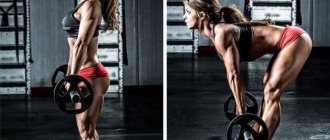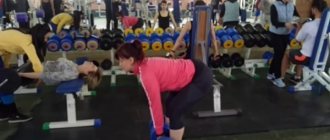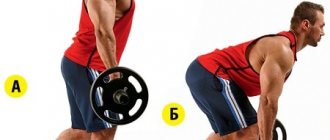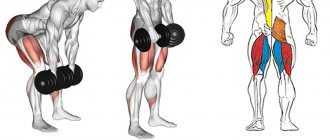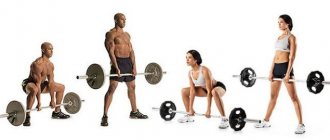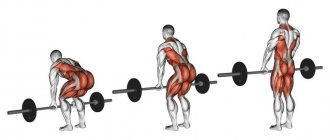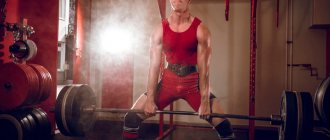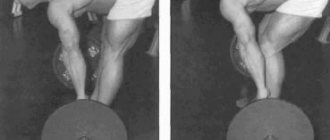One of the most effective exercises for training the hamstrings and buttocks is the Romanian deadlift. The element is one of the variations of the classic deadlift and is suitable for both men and women. In addition to the target muscles, deadlifts also target the calf, psoas, and trapezius muscles.
History of the exercise
It was named after the Romanian weightlifter Nicolae (Nicu) Vlad, Olympic medalist in 1984, 1988 and 1996. He was elected to the International Weightlifting Federation Hall of Fame in 2006. According to Jim Schmitz, former coach of the US national weightlifting team, Vlad performed these exercises with a straight back in preparation for the clean and jerk, doing triples (three repetitions per set) of 250 kg. Several other weightlifters asked him what the exercise was called, but Nicu and his coach Dragomir Cioroslan did not call the movement anything. They simply stated that they do it regularly because it helps Nicola strengthen his back for the snatch. So other athletes and coaches simply started calling it the “Romanian deadlift.”
Execution technique
The Romanian deadlift starts from the top position (bar above the knees), then the bar moves down towards the floor. If an athlete has back problems, it is best to take the barbell from the racks before performing the exercise. Step 1: Hang the weight on a barbell with your feet shoulder-width apart and the bar over your instep (laces). It is very important in this position that the torso is straight, arms are straightened, and shoulder blades are pulled back. This will make it possible to fix your back and minimize the load on your neck. Step 2: Bend over and grab the barbell slightly wider than shoulder-width apart and bend your knees slightly. Keep your back straight and your shoulders over the bar. Step 3: Push your hips back while keeping your back straight. As a result, you will feel tension in your calves and back, while your torso moves forward. Step 4: Use your glutes and hamstrings to push yourself up, keeping the barbell close to your torso. To keep the barbell tight to your body, use your latissimus dorsi muscles rather than your arm strength. The barbell should move only in a strictly vertical plane (up and down) during the exercise. Step 5: At the top of the movement, tighten your upper back, torso, and glutes. Avoid bending back or leaning more than necessary. Step 6: Lower the barbell down in a classic deadlift style, touch the floor, and then lift it up.
Lifting the barbell is accomplished by pushing the floor back with your legs, rather than by straightening your torso. It is performed smoothly and powerfully, without jerking, and the back is always straight.
Common mistakes
Next, we will analyze the most typical mistakes when performing the Romanian deadlift with a barbell.
hunched back
A common mistake among beginners and amateurs. This error leads to a decrease in the effectiveness of the Romanian traction. Additionally, rounding your back can cause spinal injury.
Incorrect position of the boom
Often the athlete is too far from the bar. For this reason, the rear end receives additional stress when removing the bar from its support or lifting it from the floor.
Bend the arm at the elbow joint
When the barbell is heavy, the athlete tries to “push” the barbell by bending his elbows. This is because the arms and forearms are not strong enough to support such weight.
If this problem occurs, it is better to have less weight or use special belts. These precautions will protect you from injury.
Holding your breath
This error can occur when performing any exercise. However, it will not be a bad idea to remember your breathing again during training. Muscles must be constantly saturated with oxygen. Their rate of growth and development depends on this. In addition, holding your breath during strength training can lead to a lack of oxygen and, as a result, loss of consciousness.
If you still have questions about the Romanian barbell deadlift, ask them in the comments. Liked? Share with your friends on social networks! ?
Share link:
5 / 5 ( 10 votes)
What muscles are involved?
The Romanian deadlift develops the same muscle groups as the regular deadlift, but with more emphasis on the hips and buttocks.
- The hamstrings receive more work due to the fact that the knees are slightly bent throughout the exercise, forcing the hips to participate in the movement.
- Buttocks. Like most other hinge movements, the Romanian deadlift engages the glutes. They participate in almost all sports movements: squats, deadlifts, running, jumping, sprints, etc., and are most involved in the Romanian deadlift.
- Lower back. Erector spinae muscles. Often, novice athletes mistakenly perceive a dull pain in the lower back as a possible error in the exercise technique, but most often this is due to increased load on the lower back. Please note that your lower back should not be the only muscle group you feel while doing this exercise. It is important that you feel more stress on the hamstrings and buttocks. If the tension in the lower back is greater than in other groups, then you are performing the exercise with the wrong technique.
- Middle and upper back . They are developed by keeping the body tense and the back straight throughout the entire exercise. As the barbell lowers, the back muscles must work harder to prevent the shoulders and upper back from rounding and flexing. This prevents injury and increases strength.
- Traps are also used to prevent forward flexion of the shoulders.
- Forearms. Developed by holding a heavy barbell for some time. Improves grip strength and muscle endurance.
Features and varieties
Often, beginners confuse the classic and Romanian deadlift with a barbell. (here are details about all types of barbell deadlifts). At first glance, they are really similar, but they have a number of differences. The classic type of deadlift is done in the direction of movement from bottom to top with legs bent at the knees. The pelvis drops quite low relative to the floor. On the next repetition, the bar actually touches the floor. Unlike the classics, the Romanian deadlift is carried out by moving from top to bottom exclusively on straight legs, and the barbell is lowered only to the middle of the shin.
Active and static effects are exerted on different muscle groups depending on the chosen type of Romanian deadlift:
- With dumbbells. It is performed using the same technique as the Romanian barbell deadlift. At the same time, it is considered a more traumatic and less effective exercise due to the uneven distribution of weight on the spine.
- Romanian single leg deadlift. This type of exercise is performed in a position on one leg – the supporting one. The dumbbell is taken in the hand opposite to the supporting one. The body leans forward until it is parallel to the floor, stays in this position for a moment and returns to the starting position.
- Romanian deadlift on straight legs. The only distinguishing feature from the Romanian deadlift is perfectly straight legs without the slightest bend in the knee joints during the exercise.
- Romanian barbell deadlift. This is a multi-joint exercise. This exercise involves to varying degrees the biceps femoris, back extensors, lumbar muscles and gluteal muscles.
Weights, sets, reps
For beginners, it is advisable to use lighter weights. Light weights are also used for warm-up sets, to improve coordination and prepare muscles for more powerful sets.
- 3-4 sets of 8-10 reps with light to medium weights at a moderate tempo, paying attention to technique.
For muscle hypertrophy (gaining muscle mass). Muscle hypertrophy occurs in response to increased training volume (number of sets and repetitions), time under load, or decreased rest between sets. Here are the recommendations:
- 3-5 sets of 6-10 reps with medium to heavy weights;
- 2-4 sets of 12-15 reps with medium weights is as close to muscle failure as possible. Rest periods are 45-90 seconds.
Development of strength. There should be a little less weight on the bar than with a classic deadlift, because in the Romanian the quadriceps practically does not contribute to the exercise.
- 3-5 sets of 3-5 reps with heavy weight. Rest as needed.
Muscular endurance. In sports such as running, CrossFit requires a high resistance to muscle fatigue. If the training is aimed at developing muscle endurance, then the number of repetitions in the approaches will be higher than in all other cases, and the weights will be lighter.
- 2-4 sets of 12-20 reps with light to medium weights. Rest periods are no more than 30-45 seconds.
Five Benefits of the Romanian Deadlift
- Growth of the hamstring muscles. Hypertrophy of these muscle fibers results in increased size, strength, and athletic performance.
- Increased traction force . This exercise is preferable to the classic deadlift in terms of loading all the back muscles of the body, and is safer for the lower back (lower back).
- An effective assistance exercise for weightlifting and CrossFit. Helps develop the muscles involved in the weightlifting snatch and clean and jerk.
- Use in other sports. Such as athletics, bobsleigh, martial arts.
- Preventing injuries. During explosive movements such as running, sprinting, jumping, and lifting weights, the hamstring muscles are most often injured. With the help of the Romanian deadlift you can significantly increase the strength of this muscle group and therefore avoid injury.
Alternative variations of the Romanian deadlift
In situations where an athlete or coach wants to replace the Romanian deadlift with something due to lower back or spinal pain, fatigue or a desire to diversify the training program, the following exercises can be used: Good morning. This is a good alternative exercise to enhance the development of the lower back and glutes while limiting the stress on the hamstrings, which are less involved. Most often performed with a barbell or expander.
Reverse hyperextensions are a very good exercise for working the buttocks and muscles that straighten the spine (its lower part), without loading the back of the thigh. The fact is that the movement occurs in the hip joint, and not in the knee or ankle. You can do it with weights, on a reverse hyperextension machine, or simply with your own body weight.
Glute ham raises are used to work the hamstrings in isolation with minimal stress on the spine. Suitable for people who want to protect their back due to injuries or too intense stress. Mostly performed with your own weight or a small weight pressed to the chest. Done with a lot of repetitions.
Scandinavian hamstring curls. Very similar to the previous exercise. The same muscles are loaded. Performed with the help of a partner, and, as a rule, done only with your own weight.
Good luck!
